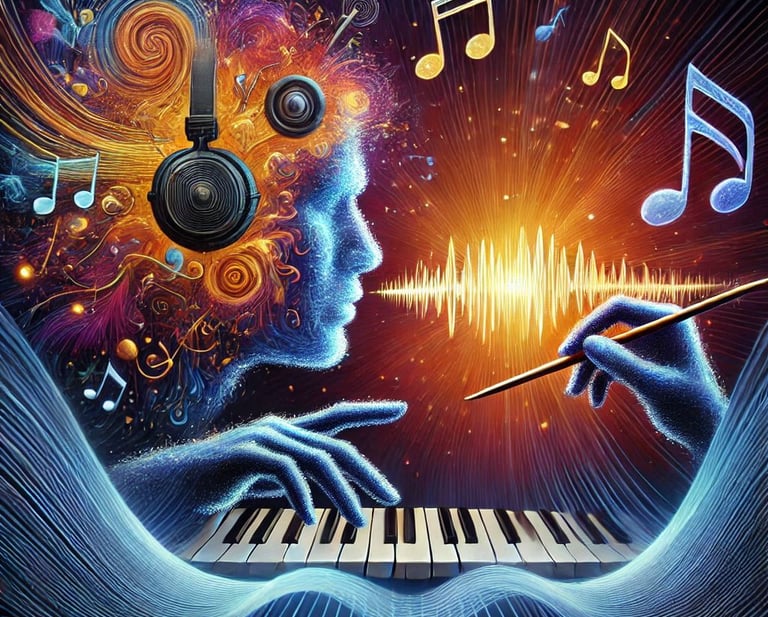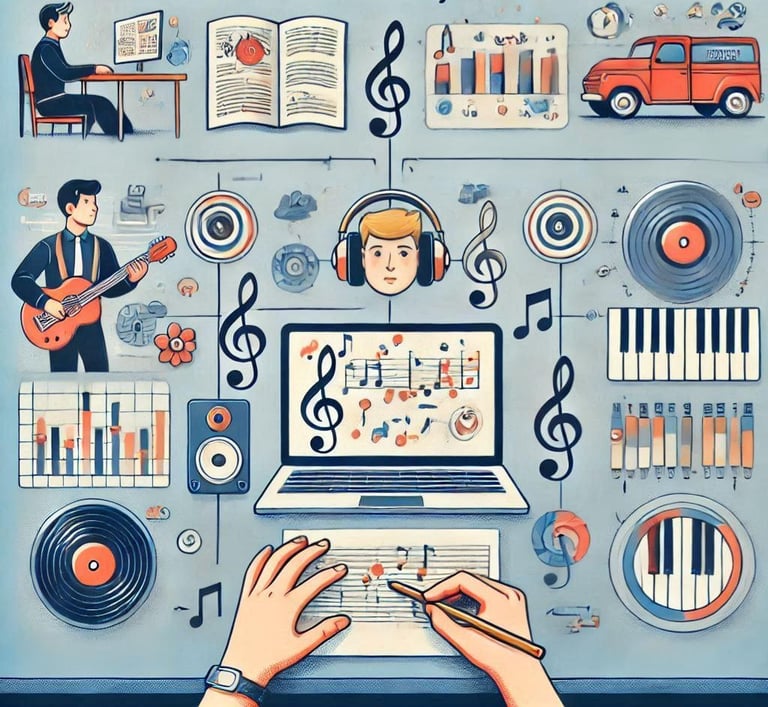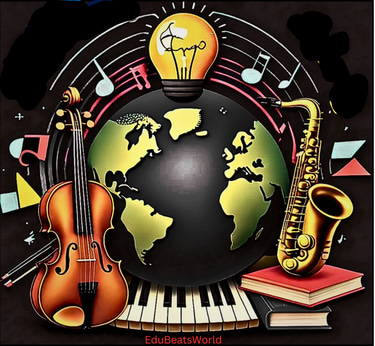The Science of Music: How Sound Waves Shape Our Learning and Emotions
edubeatsworld.com
["This page contains affiliate links. If you purchase through these links, I may earn a small commission at no extra cost to you. Learn more."]
For centuries, music has served as a universal language, effortlessly transcending cultural and linguistic barriers. Beyond its aesthetic and entertainment value, music exerts a significant influence on our cognitive, emotional, and social well-being. The complex interplay between sound waves, the human brain, and our emotions offers profound insights into why music is not merely an art form but also a powerful tool for learning and emotional regulation. In this post, we explore the science of music, examining its effects on learning and emotions, and discussing how both educators and learners can effectively harness its potential.
The 'Physics of Sound': Understanding the Basics
At its core, music consists of sound waves that travel through the air and engage with our auditory system. These sound waves are vibrations characterized by varying frequencies and amplitudes, which produce distinct pitches and volumes. When these waves reach our ears, they are transformed into electrical signals and transmitted to the brain for processing.
The brain’s auditory cortex, which resides in the temporal lobe, is responsible for interpreting these signals. Research indicates that the brain responds differently to various types of music: for example, fast-paced rhythms can stimulate the motor regions, while slower melodies often activate areas linked to relaxation and introspection. By understanding these fundamental principles, educators can design music-based interventions tailored to achieve specific learning outcomes.
Example:
Playing 'soft instrumental music' during independent reading can enhance concentration in a classroom setting, while upbeat tracks during physical activities can elevate energy levels and boost student engagement.


Music’s Emotional Impact: Why Do We Feel?
Music possesses a remarkable ability to evoke emotions, often more intensely than words alone. This phenomenon can be attributed to the brain’s limbic system, particularly the amygdala and hippocampus, which are key players in processing emotions and forming memories. Research indicates that music activates the brain's reward system, triggering the release of 'dopamine'—the "feel-good" neurotransmitter—thereby creating feelings of pleasure and motivation.
Quotation:
As Friedrich Nietzsche aptly said, "Without music, life would be a mistake."
The Role of Tonality and Tempo:
Major Keys: Very often associated with feelings of happiness and optimism.
Minor Keys: Known to often evoke emotions of sadness or introspection.
Fast Tempos: Energizing and uplifting, promoting a sense of excitement.
Slow Tempos: Calming and reflective, encouraging relaxation and contemplation.
Example:
Consider the contrast between Beethoven's "Ode to Joy" and Chopin's "Nocturnes." The former radiates exuberance and celebration, while the latter evokes a sense of calm and introspection.
Case Study: A study conducted by researchers at Stanford University discovered that listening to classical music can effectively regulate mood and lower stress levels. This highlights the potential of music as a powerful tool for promoting emotional well-being and fostering a calmer, more balanced state of mind.
'Music and Memory: Enhancing Cognitive Skills'
One of the most intriguing aspects of music is its profound impact on memory and learning. In the 1990s, the "Mozart Effect" theory suggested that listening to classical music could temporarily boost spatial-temporal reasoning. While the specifics of this effect are still debated, a broader consensus affirms that music stimulates brain activity, enhancing both memory and cognitive function.
Mechanisms at Work:
Chunking Information: Music aids in breaking down complex information into smaller, more memorable units. For instance, children often learn the alphabet through the "ABC Song."
Emotional Context: The emotional resonance of music makes information more relatable and easier to recall.
Rhythm and Repetition: These elements strengthen neural pathways, facilitating long-term retention.
Example:
Students studying historical events may find it easier to remember dates and facts through songs or rhymes, such as the iconic "We Didn’t Start the Fire" by Billy Joel.


Practical Applications in Education
Integrating music into educational settings can revolutionize traditional teaching methods, making learning more engaging and effective. Here are some practical ways educators can leverage music:
1. 'Background Music for Focus':
Listening to instrumental music during study sessions can boost concentration by drowning out distracting background noise and fostering a serene atmosphere for focused learning.
2. Subject-Specific Songs:
Creating songs or jingles that incorporate academic content can significantly enhance retention. For example, math teachers can leverage rhythm and melody to teach multiplication tables, transforming a challenging task into a fun and engaging activity. This approach not only makes learning enjoyable but also helps students memorize information more easily and reinforces their understanding through musical repetition.
3. Group Activities:
Integrating music into collaborative tasks promotes teamwork and enhances communication skills among participants. Activities like singing in unison or playing instruments together cultivate a sense of community, encouraging individuals to work harmoniously and develop strong interpersonal connections.
4. Encourage Music Creation:
Allow students to write and perform their own songs about the subject matter, fostering creativity and deeper understanding.
5. Mindfulness with Music:
Use calming music during transitions or moments of reflection to create a positive classroom atmosphere.
6. Singing for Language Learning:
Use songs in different languages to aid vocabulary acquisition and pronunciation practice.
Quotation:
“Music can change the world because it can change people.” – Bono
Case Study:
A middle school in New York integrated rap music into its history lessons, allowing students to better recall key events and engage more deeply with the material. This innovative approach not only made learning more relatable and enjoyable but also resulted in a significant improvement in test scores, underscoring the effectiveness of using music to enhance educational outcomes.
Music’s Role in Emotional Regulation
Beyond academics, music is essential for emotional well-being. It serves as a powerful outlet for self-expression, enabling individuals to convey their feelings and thoughts. Additionally, music can help manage stress by providing a soothing escape from daily pressures and enhancing resilience in the face of life’s challenges.
'Music therapy' is a clinical intervention that leverages these principles, utilizing structured music activities to address mental health issues and developmental challenges. Through techniques such as songwriting, improvisation, and active listening, music therapy not only promotes emotional healing but also improves social skills and fosters personal growth.
Techniques in Emotional Regulation:
Active Listening: Engaging deeply with music can serve as a powerful means of processing emotions. Whether through active listening, playing an instrument, or creating music, individuals often find that music resonates with their feelings, helping to articulate things that might be difficult to express in words. This immersive experience can foster introspection, allowing listeners to explore their emotional landscape and gain clarity on their thoughts and feelings. Moreover, certain genres or songs can evoke specific memories or emotions, facilitating catharsis and self-discovery. Through this deep engagement, music not only provides comfort and solace but can also lead to healing and personal growth as individuals navigate their emotional experiences.
. Improvisation: Improvising music offers a unique and spontaneous outlet for releasing pent-up feelings. When individuals create music in the moment—whether by playing an instrument, singing, or using digital tools—they tap into their emotions and allow them to flow without the constraints of structure or judgment. This freedom encourages authenticity and can lead to profound emotional expression, helping to alleviate stress and anxiety. The act of improvisation can be both cathartic and liberating. As musicians or singers spontaneously explore melodies, rhythms, and harmonies, they often find a way to articulate feelings they may not even have been consciously aware of. Engaging in this practice allows for a deeper connection with one's emotions, fostering a sense of release and renewal. In group settings, musical improvisation can also promote bonding and communication, as participants respond to each other’s cues and emotions. This collaborative creation can enhance feelings of belonging and support, making improvisation a valuable tool for emotional healing and self-discovery.
. Lyric Analysis: Exploring the meaning of songs can provide profound insights into our personal experiences and emotional landscapes. Lyrics often encapsulate feelings, stories, and struggles that resonate deeply with listeners, helping them to reflect on their own lives. By analyzing a song's themes, metaphors, and narratives, individuals can draw parallels to their own journeys, fostering a sense of connection and understanding. For instance, a song about heartbreak might evoke memories of a past relationship, prompting listeners to process their feelings of loss and longing. Similarly, an uplifting anthem about resilience can inspire hope and motivation, encouraging individuals to confront their own challenges. Engaging with music in this way not only promotes introspection but also hones emotional intelligence. As listeners identify with the emotions conveyed in the lyrics, they can gain clarity on their own feelings and experiences, leading to greater self-awareness and healing. Moreover, discussing song meanings with others can be a valuable form of social interaction, allowing for shared experiences and perspectives, which can enrich personal understanding. In this way, music becomes not just a source of entertainment but also a powerful tool for personal growth and emotional exploration.
Example:
A study published in Frontiers in Psychology found that listening to calming music before exams significantly reduced anxiety levels among students. This underscores the potential of music as an effective tool for managing stress and promoting a more relaxed mindset in high-pressure situations, enhancing students' overall performance.
Case Study:
A music therapy program in Chicago successfully assisted veterans suffering from PTSD in managing their symptoms by encouraging them to compose and perform their own songs. This creative approach provided a therapeutic outlet for expression, allowing veterans to articulate their experiences and emotions through music. As a result, participants reported improved emotional well-being and a greater sense of connection with others, highlighting the powerful role music can play in healing and recovery.
'Music and Neuroplasticity': Shaping the Brain
Neuroplasticity, the brain's ability to adapt and reorganize itself, plays a crucial role in learning. Music enhances neuroplasticity by simultaneously stimulating multiple brain regions, including those involved in auditory processing, motor control, and emotional regulation. This multifaceted stimulation can strengthen neural connections and promote cognitive development, making music a valuable tool not only for personal expression but also for educational and therapeutic purposes.
Evidence:
A study by Schlaug et al. (2005) found that musicians have larger corpus callosums, the structure that connects the brain's two hemispheres, suggesting enhanced communication between brain regions. This anatomical difference supports the idea that musical training fosters greater integration of cognitive functions, potentially benefiting various aspects of brain processing and overall cognitive performance.
Implication:
Introducing music education at an early age can significantly foster neural development, enhancing skills such as problem-solving, creativity, and adaptability. Engaging with music not only stimulates various areas of the brain but also encourages critical thinking and innovative thought processes, helping children develop a well-rounded skill set that can benefit them in academic and social settings.
Cultural and Social Dimensions of Music
Music's impact extends far beyond the individual, acting as a powerful cultural artifact that preserves traditions and fosters a sense of identity within communities. In educational settings, integrating diverse musical genres not only celebrates cultural heritage but also promotes cultural awareness and inclusivity. This approach encourages students to appreciate different perspectives and experiences, enriching their understanding of the world and fostering a sense of belonging in a diverse society.
Example:
Incorporating 'African drumming', Indian classical music, and Latin American rhythms into lessons can effectively expose students to global cultures, broadening their perspectives. This exposure not only enhances their musical education but also fosters appreciation for cultural diversity and promotes understanding of different traditions and values. Through active engagement with these rich musical heritages, students can develop a more inclusive worldview and a deeper respect for cultural differences..
Quotation:
"Music is the universal language of mankind." – Henry Wadsworth Longfellow
Case Study:
A school in California implemented a world music program, allowing students to explore instruments and styles from different cultures. This initiative not only improved students’ musical skills but also fostered greater empathy and understanding among peers.
Conclusion: Harnessing the 'Power of Music'
The science of music underscores its profound influence on our brains, emotions, and learning capabilities. By understanding the mechanisms behind music’s effects, educators, learners, and individuals can unlock its full potential. Whether it’s improving memory through rhythmic patterns, regulating emotions with soothing melodies, or fostering cultural awareness through diverse genres, music is a powerful ally in education and personal growth.
As we continue to explore the intersection of music and science, one thing is clear: the harmony of sound waves and neural connections has the power to shape not just our minds, but also our lives. Embracing music as a tool for learning and emotional well-being can transform classrooms, communities, and individual journeys alike.
contact@edubeatsworld.com
© 2024. All rights reserved.
